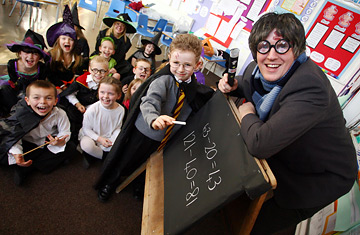
Pupils enjoy a wizard-themed lesson at the Robert Mellors primary school.
Two hours from platform 9 at London's King's Cross station, a cluster of students in starry robes, pointed hats and rep ties are learning how plants grow, but it's not botany; they call it "herbology." In an adjacent classroom a boy with a famous lightning-bolt scar brandishes his wand, chants "Numerus Subtracticus!" and conjures the correct answer to a math problem.
Robert Mellors Primary School on the outskirts of Nottingham, England, is a long way from the verdant lawns and haunted forests of Hogwarts School of Witchcraft and Wizardry, the main setting of J.K. Rowling's Harry Potter books. But by borrowing elements from that fantastic realm, this once-failing school has turned itself around as if by magic dust.
"Historically, the school had a really bad reputation," says Donna Chambers, head teacher at this institution of about 250 nursery and primary schoolers, which serves one of the most deprived sections of Nottingham. Charged with rejuvenating the state-run school, where "children come in well below national averages," Chambers has taken the innovative approach of organizing all subjects around a single theme, which the students themselves select by simple vote. "We were in a situation where we could take that risk," Chambers says. Past semesters have been centered on Africa, the Titanic and chocolate. This semester, students were given the stipulation that the organizing principle would be a book, and Harry Potter edged out The Lion, the Witch and the Wardrobe. The result, Chambers says, has been "phenomenal."
The theme-based approach has catalyzed a dizzying rise in academic achievement at Robert Mellors. Three years ago it was languishing in the bottom quarter of English schools; it has since vaulted into the top 25%. A September visit from Ofsted, England's educational inspection body, yielded a rating of "outstanding," and special kudos were given for the school's ability to mentor pupils with learning disabilities or behavioral problems. "The school recognizes that pupils will only be successful if lessons are stimulating," the report said.
While Rowling's tales have long been cultural touchstones and commercial blockbusters, at Robert Mellors they permeate every aspect of this term's studies. In literacy classes, students learn to distinguish between types of prose by writing their own screenplays based on Potter's exploits; they pick up the basics of geography by plotting locations used in the Potter films. The student body is divided into the four "houses" in Rowling's novels — Hufflepuff, Gryffindor, Ravenclaw and Slytherin — and earn "house points" for academic achievement, just as in the books. "It's made school a lot easier and better," says 10-year-old Chantelle. "Everybody likes going to school."
Robert Mellors, nestled among two-story brick homes in an ordinary residential neighborhood, has none of the grandeur and mystery of Hogwarts, let alone its cavernous dining hall. But here, as in the books from which it drew inspiration, the key to success has been the wondrous power of a child's imagination. "By the nature of the beast, children are more creative than we are," Chambers says. "So they will make the connections and do it enthusiastically." The Robert Mellors School proves that when education is packaged to encourage those connections, it can cast a powerful spell — just like the Ollivander wand favored by Harry Potter.
